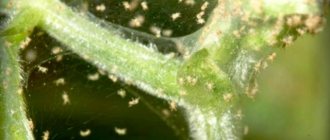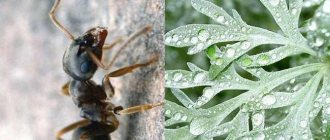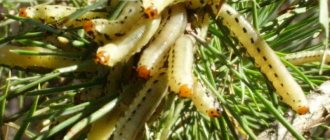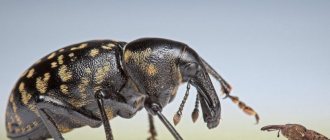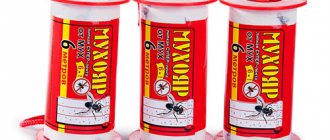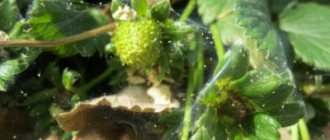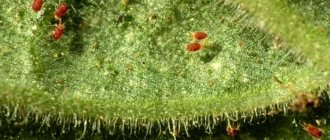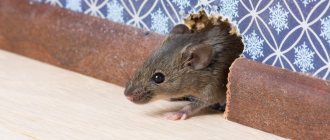| Place | Name | Characteristics in the rating |
| The best acaricides for spider mites |
| 1 | Neoron | Best for controlling ticks at all stages of their development |
| 2 | Apollo | Lowest toxicity. Long validity period up to 60 days |
| 3 | Omite | Prolonged effect for 3 weeks |
| The best insectoacaricides for spider mites |
| 1 | Aktellik | The most versatile remedy |
| 2 | Fufanon | Analogue of Karbofos |
| 3 | Talstar | Safe for bees |
| The best biological products for spider mites |
| 1 | Fitoverm | The best enteric contact bio-insectoacaricide |
| 2 | Kleschevit | The most popular |
| 3 | Bitoxibacillin | Best in terms of security |
| 4 | Metarizin | Acts slowly and prolonged |
Almost everyone has to fight spider mites, which attack vegetable crops in open ground and greenhouses, and also often appear on indoor plants, from time to time. The pest is tiny in size, but can adapt to different living conditions. The only solution is to regularly treat the plants using special means to combat the parasite.
Effective drugs against spider mites will help save flowers in the apartment, protect cucumbers and other vegetable crops in the garden. There are many means available for these purposes. They differ in price, composition and principle of action. We have compiled a rating of the best drugs against spider mites, based on reviews from gardeners.
Results of a review of anti-spider mite remedies
Summing up our review, it should be noted that any pesticides have their drawbacks, a strong odor, allergies, and the need for ventilation after treatment. Experienced flower growers know that chemistry, as a remedy for spider mites , is the most extreme measure. Preventing the appearance of ticks and creating barriers to their appearance in the apartment is the best way to avoid misfortune.
Beautiful and healthy plants for you
Instructions for the use of acaricides
Acaricidal preparations against ticks are used for spraying the above-ground parts of plants. To do this, prepare a solution in specially designated plastic, glass or enamel containers. The skin of the hands is protected with rubber gloves, the respiratory organs and eyes are protected with respirators and glass goggles.
The preparation method for most acaricidal preparations is the same:
- First, take half of the total volume of water, dilute the required amount of the drug until a homogeneous liquid is obtained.
- Then the rest of the water is added to the container and the resulting liquid is intensively mixed.
- The composition is poured into the spray tank.
The solution is used immediately in full. It cannot be stored for more than one day.
Where do spider mites come from on houseplants?
There are a great many sources of spider mites appearing on house plants . We list both the most basic and the most unexpected, at first glance, routes of infection:
Most often, the tick “arrives” in the house on the leaves of purchased indoor plants . All flower growers unanimously repeat: if you bought a new flower in a store or from hand, do not immediately place it on your plants. Place the newcomer in quarantine on a separate windowsill, or better yet, immediately wash the crown of the plant with laundry soap and carry out preventive spraying with any pest control agent.
The second most “popular” route of infection is flower bouquets . If you brought a bouquet of your garden flowers or were given one for a holiday, try to place the vase with flowers away from indoor plants.
In third place, spider mite infection through the ground . Experienced gardeners never prepare planting mixtures in the same room where the plants are located. Spider mite eggs can sleep peacefully in the ground for up to 5 years, waiting for favorable conditions. Any soil, forest garden soil or store-bought soil, must be calcined in the oven, because it may contain many dangerous bacteria, fungal spores and pest eggs.
The fourth way to become infected with mites perfectly explains how they “out of the blue” appear on plants. Attention! Spider mites can fly! Of course, they do not have wings, but the thin webs produced by the glands of the tick can serve as an excellent parachute, allowing them to soar with the wind over vast distances.
Ticks can also be brought on clothing , shoes, an umbrella, or even on a Christmas tree.
The crown of the plant, entangled in cobwebs from spider mites
There are a great many ways for spider mites to enter your home, and even if this attack has passed for now, you should be prepared for the possible appearance of these uninvited guests.
How not to deal with spider mites
- When purchasing a new plant, isolate it from your flowers;
- Maintain room humidity; mites love dry air;
- Rinse the leaves of plants regularly, preferably with the addition of laundry soap;
- Inspect houseplants daily for signs of infestation;
- Follow agricultural practices, because healthy and strong plants are very unattractive to the pest.
Attention to plants returns in the form of their beauty and health
When diluting a solution to combat spider mites on indoor plants, be sure to follow the instructions for use on the package. The recommendations posted here are based on currently available products, but the manufacturer may vary the concentration of the active ingredient from batch to batch.
And here you can learn even more about methods of combating spider mites on homemade lemons.
Arsenal of chemicals for pest control
There is a wide range of drugs available to control pests on houseplants. These are insecticides, acaricides, and insectoacaricides . Buyers coming to a country store are sometimes simply not able to independently navigate the variety of multi-colored bottles, ampoules, tubes, powders and sprays on offer. instructions for use flash one after another , you can go crazy. Therefore, we will try to understand this variety of drugs and find effective chemicals for spider mites .
Holes on a leaf that an insect leaves when feeding on its juice
Insecticides
This term refers to a wide range of drugs of natural or chemical origin intended to destroy various types of pests.
All drugs in this group can be divided into several criteria:
According to the method of destroying pests, the following drugs are distinguished:
- Intestinal - penetrate the body of pests along with food, are especially effective for destroying various leaf-eating insects and moths.
- Contact - kill pests as a result of contact with their body. It is this group of drugs that is used in industrial agriculture for spraying onto fields from aircraft.
- Systemic - a group of drugs that are absorbed by plants, making their juice poisonous to pests. Unlike intestinal preparations, which remain as a film on the surface of the leaf, systemic preparations will not be washed away by rain or watering.
- Respiratory - a group of sprays familiar to everyone that kill pests through the respiratory system.
- Translaminar - a group of drugs that can spread from the point where drops of the drug hit the entire untreated surface of the plant.
According to the spectrum of impact on pests of one or another group, the following are distinguished:
- Antihelminetics are drugs used mainly in veterinary medicine, livestock and poultry farming to combat worms, roundworms, pinworms and other exoparasites of animals and poultry.
- Nematicides are used to destroy nematodes, in particular those types of roundworms whose presence is undesirable, in other words, pests.
- Acaricides are a specialized group of drugs to combat ticks. These are the drugs that will help gardeners effectively combat spider mites on plants . Let's talk about them in more detail.
Insecticidal preparations are available for retail sale in the following forms:
- In the form of a concentrated suspension, abbreviated as CS . It is a liquid solution containing tiny, solid particles. If you leave the suspension on a shelf for a long time, you may notice the release of sediment. It is on drugs of this class that it is written “Shake before use/use.”
- In the form of a concentrated emulsion, abbreviated as CE . It is a mixture of two types of liquids. An example of an emulsion would be a mixture of oil and water. Emulsions, like suspensions, are prone to separation, so they should also be shaken thoroughly before use.
- In the form of sticks containing the drug, abbreviated as P. The most convenient form of release for flower growers, which allows you to avoid various spraying and dusting. It is enough to simply place the stick in a pot with an infected plant and wait for the inevitable death of the pests.
- In the form of a wettable powder, abbreviated as SP . This form of release is a tiny powder with which surfaces are dusted. A classic example, banned in our time, but familiar from childhood, is DDT, or dust.
Top Chemicals for 2022
When using drugs from this group, it is important to strictly follow the dosage and number of treatments in accordance with the attached instructions. Chemical agents that destroy ticks are divided into two groups:
- insectoacaricides;
- acaricides.
To effectively get rid of the pest, you should alternate products with different components in the composition. Many products cease to perform their function after repeated treatment.
If you need to use chemicals, you must follow a number of simple but important rules:
- During use, wear long sleeves, gloves and a hat to protect skin, mucous membranes and hair. The best place for spraying chemicals is a balcony, loggia.
- For indoor flowers, choose products with toxicity class 3-4. Highly toxic substances are only suitable for outdoor plants.
- In case of serious infection, it is necessary to carry out not one, but 4 treatments with an interval of 5-7 days.
Examples of chemicals and their use are presented in the table:
| Name | Protection time (days) | Peculiarities |
| Akarin | 8-15 | Provides assistance within 48 hours. Suitable for roses, violets and orchids. |
| Aktara | 14 | It does not have an unpleasant odor, but is considered ineffective against ticks. |
| Aktellik | Toxic, it is better to spray outside. Do not allow it to get into the ground. | |
| Anti-mite | 7-9 | Defeats different types of pests. |
| Apollo | 60-90 | Sterilizes adults. |
| Bi-58 | 21 | Prevents the emergence of new colonies of parasites. |
| Nissan | 50 | The effect is visible after 11 days. |
| Neoron | 10-40 | Can be used at any humidity and air temperature. |
| Omite 30 and 57 | 14 | Available in different dosages. |
| Oberon | 20-25 | Destroys all stages of insects: eggs, larvae, adult females, except males. |
| Sunmite | 30-35 | The impact on masonry is minimal. |
| Skelta | 80-85 | The death of the pests occurs within a week. Requires re-spraying after 8 days. |
| Fitoverm | 20 | Low toxicity, but re-treatment is required. |
Due to the fact that all mites are similar in structure, flower growers use drugs used in veterinary medicine to treat animals, for example, Neostomozan.
For treatment to be effective, it is better to alternate the use of acaricides and water procedures. Plants in large tubs, as well as specimens with curled leaves or curly dense crowns, for example, ficus, are best dipped into a bucket with diluted products, greens side down, for 1-2 minutes.
MOST READ FROM PARTNERS
Sometimes on forums they suggest using Dichlorvos. This should not be done, the product does not help against ticks, but when sprayed in an apartment it is harmful to human health.
Almost everyone has to fight spider mites, which attack vegetable crops in open ground and greenhouses, and also often appear on indoor plants, from time to time. The pest is tiny in size, but can adapt to different living conditions. The only solution is to regularly treat the plants using special means to combat the parasite.
Effective drugs against spider mites will help save flowers in the apartment, protect cucumbers and other vegetable crops in the garden. There are many means available for these purposes. They differ in price, composition and principle of action.
Characteristic symptoms of infection
Spider mites are very small insects, so no visible symptoms appear immediately after a plant is infected. But as the pest population increases, clear signs of infection appear:
A silvery web is visualized. When heavily infested, it envelops all plants. While the tick colony has not yet increased, the cobweb is hardly noticeable. Because of this, novice flower growers and gardeners may miss the initial stage of infection.
The pest pierces the surface of the leaf blades with a sharp proboscis in order to suck out nutrients. The tissues adjacent to the punctures die. Visually this is manifested by the appearance of very small dots. They may have a greenish or light yellow color. After some time, they merge into more noticeable spots.
The parasite leaves its waste products, dynamically changing its location on the plant or moving to a neighboring one. They resemble small black grains that are easy to separate from the surface of the leaves.
If the affected plant is not taken care of, it will quickly die. Microscopic wounds left by spider mites cause yellowing and wilting of leaves and young shoots. The condition is aggravated if mycosis also develops. The plant will most likely die, but first the damaged parts will fall off.
Why is it dangerous?
Spider mites are herbivorous arachnids.
Their main food is cell sap, which they suck out through numerous punctures on the leaves. The affected leaves dry out and fall off, the plant cannot develop normally, form buds and fruit ovaries.
Moving from one plant to another, mites carry dangerous viruses, fungi, and bacteria. Arachnids are not capable of flying, but are easily transported by the wind along with cobwebs. After overwintering, the pests quickly restore the population and can completely destroy the crop.
Types of mites and which trees are affected (in the garden)
Today there are many different types of spider mites known. All of them affect some plants and crops. Here we will note only the most common varieties of these insect pests.
So, among the most famous spider mites, today we can easily distinguish the following types:
- The common spider mite infects grapes, fruit and stone fruit plants, berries, as well as grains, legumes, and decorative indoor and outdoor crops.
- Red spider mite - damages balsam, lemon, nightshade, roses, orchids.
- The hawthorn mite can be found on Rosaceae: cherry plum, hawthorn, plum, apricot, rowan, apple tree.
- The date spider mite loves melons, eggplants, date palms, and a variety of grains.
- Petrobia polyphagous is capable of infecting over two hundred economically important plants, in particular various cereals, onions, asparagus, strawberries, garlic, cucumbers, spices, clover, and various legumes.
- The Turkestan spider mite settles on Theophrastus abutilon, acacia, cotton, mantle, sunflower, burdock, alfalfa, field bindweed, swan, melon, watermelon, nutmeg pumpkin, datura, cucumber, quince, common hop, and ve white, plum, nightshade, clover, eggplant, grapes, elm and corn.
- The Atlantic spider mite loves cotton, apple and pear trees, clover, alfalfa, and strawberries.
- The red fruit mite can be found on deciduous rosacea trees. In addition, it often attacks grapes, alder, elm, oak, linden and mulberry.
- The red citrus mite is very fond of tangerines, oranges, lemons and other citrus crops.
Frequency of application
How often to use the acaricidal drug depends on the technical characteristics. Some systemic substances are actively absorbed by plant parts, so their use before harvesting fruits is strictly prohibited.
Acaricidal preparations against ticks are used not only to eliminate ticks, but also to repel other insects. Acaricides can be used as preventive drugs, as well as as a comprehensive measure to eliminate an existing problem.
